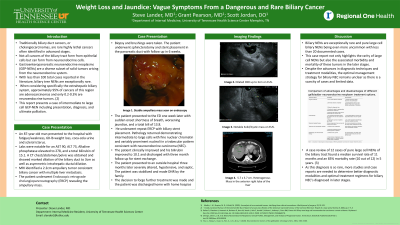Tuesday Poster Session
Category: Biliary/Pancreas
P2937 - Weight Loss and Jaundice: Vague Symptoms from a Dangerous and Rare Biliary Cancer
Tuesday, October 24, 2023
10:30 AM - 4:00 PM PT
Location: Exhibit Hall

Has Audio

Steven Lander, MD
University of Tennessee Health Science Center
Memphis, TN
Presenting Author(s)
Steven Lander, MD, Grant Pearson, MD, Ronald S.. Jordan, DO
University of Tennessee Health Science Center, Memphis, TN
Introduction: Traditionally, biliary duct cancers, or cholangiocarcinomas, are rare highly lethal cancers often identified in advanced stages. Not all cancers of the biliary tract form from epithelial cells but rather from neuroendocrine cells. Gastroenteropancreatic neuroendocrine neoplasms (GEP-NENs) are a diverse subset of solid tumors arising from the neuroendocrine system. With less than 100 total cases reported in the literature, biliary tree NENs are exceptionally rare. When considering specifically the extrahepatic biliary system, approximately 95% of cancers of this region are adenocarcinomas and only 0.2-0.3% are neuroendocrine tumors. (2) This report presents a rare very case of intermediate to large cell GEP-NEN including presentation, diagnosis, and ultimate palliation.
Case Description/Methods: An 87-year-old man presented to the hospital with fatigue/weakness, 60-lb weight loss, and scleral icterus. Labs were notable for an AST 90, ALT 73, Alkaline phosphatase 278, and a total bilirubin of 15.1. A CT chest/abdomen/pelvis was obtained and showed marked dilation of the biliary duct to 3cm and asymmetric intrahepatic ductal dilation. MRI identified a 2.2cm ampullary tumor consistent biliary cancer with multiple liver metastasis. The patient underwent ERCP with sphincterotomy, biliary stenting and biopsy. The pathology results from the biliary mass returned resulting as a highly mitotic large cell neuroendocrine carcinoma. The patient clinically improved and was scheduled for follow-up with oncology and stent replacement. Within three months, he presented again septic with altered mental status. Patient ultimately forwent further treatment and went to hospice care.
Discussion: Biliary NENs are exceptionally rare and pure large cell biliary NENs being even more uncommon with less than 20 documented cases. This clinical case not only highlights the rarity of large cell NENs but also the associated morbidity and mortality of these tumors in the later stages. Despite the advances in diagnostic techniques and treatment modalities, the optimal management strategy for biliary NEC remains unclear as there is a scarcity of cases and limited data. A case review of 12 cases of pure large cell NENs of the biliary tract found a median survival rate of 11 months and an 83% mortality rate (10 out of 12) in 5 years. (3) As this diagnosis is so rare, more studies and case reports are needed to determine better diagnostic modalities and optimal treatment regimens for biliary NEC’s diagnosed in later stages.
Disclosures:
Steven Lander, MD, Grant Pearson, MD, Ronald S.. Jordan, DO. P2937 - Weight Loss and Jaundice: Vague Symptoms from a Dangerous and Rare Biliary Cancer, ACG 2023 Annual Scientific Meeting Abstracts. Vancouver, BC, Canada: American College of Gastroenterology.
University of Tennessee Health Science Center, Memphis, TN
Introduction: Traditionally, biliary duct cancers, or cholangiocarcinomas, are rare highly lethal cancers often identified in advanced stages. Not all cancers of the biliary tract form from epithelial cells but rather from neuroendocrine cells. Gastroenteropancreatic neuroendocrine neoplasms (GEP-NENs) are a diverse subset of solid tumors arising from the neuroendocrine system. With less than 100 total cases reported in the literature, biliary tree NENs are exceptionally rare. When considering specifically the extrahepatic biliary system, approximately 95% of cancers of this region are adenocarcinomas and only 0.2-0.3% are neuroendocrine tumors. (2) This report presents a rare very case of intermediate to large cell GEP-NEN including presentation, diagnosis, and ultimate palliation.
Case Description/Methods: An 87-year-old man presented to the hospital with fatigue/weakness, 60-lb weight loss, and scleral icterus. Labs were notable for an AST 90, ALT 73, Alkaline phosphatase 278, and a total bilirubin of 15.1. A CT chest/abdomen/pelvis was obtained and showed marked dilation of the biliary duct to 3cm and asymmetric intrahepatic ductal dilation. MRI identified a 2.2cm ampullary tumor consistent biliary cancer with multiple liver metastasis. The patient underwent ERCP with sphincterotomy, biliary stenting and biopsy. The pathology results from the biliary mass returned resulting as a highly mitotic large cell neuroendocrine carcinoma. The patient clinically improved and was scheduled for follow-up with oncology and stent replacement. Within three months, he presented again septic with altered mental status. Patient ultimately forwent further treatment and went to hospice care.
Discussion: Biliary NENs are exceptionally rare and pure large cell biliary NENs being even more uncommon with less than 20 documented cases. This clinical case not only highlights the rarity of large cell NENs but also the associated morbidity and mortality of these tumors in the later stages. Despite the advances in diagnostic techniques and treatment modalities, the optimal management strategy for biliary NEC remains unclear as there is a scarcity of cases and limited data. A case review of 12 cases of pure large cell NENs of the biliary tract found a median survival rate of 11 months and an 83% mortality rate (10 out of 12) in 5 years. (3) As this diagnosis is so rare, more studies and case reports are needed to determine better diagnostic modalities and optimal treatment regimens for biliary NEC’s diagnosed in later stages.
Disclosures:
Steven Lander indicated no relevant financial relationships.
Grant Pearson indicated no relevant financial relationships.
Ronald Jordan indicated no relevant financial relationships.
Steven Lander, MD, Grant Pearson, MD, Ronald S.. Jordan, DO. P2937 - Weight Loss and Jaundice: Vague Symptoms from a Dangerous and Rare Biliary Cancer, ACG 2023 Annual Scientific Meeting Abstracts. Vancouver, BC, Canada: American College of Gastroenterology.
